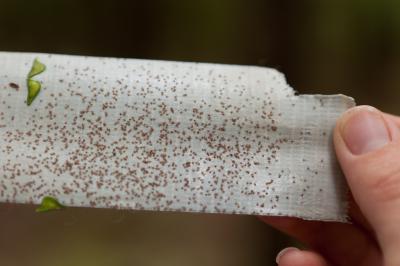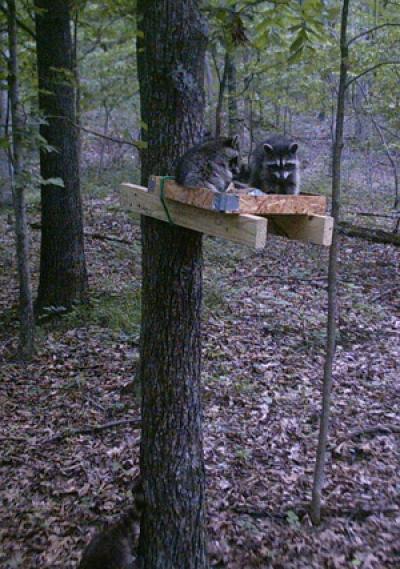Here's a riddle: What's the difference between a tick and a lion? The answer used to be that a tick is a parasite and the lion is a predator. But now those definitions don't seem as secure as they once did.
A tick also hunts its prey, following vapor trails of carbon dioxide, and consumes host tissues (blood is considered a tissue), so at least in terms of its interactions with other creatures, it is like a lion — a very small, eight-legged lion.
Ecologists are increasingly finding it useful to think of parasites, such as ticks, as micro-predators and have been mining predator-prey theory for insights into parasite-host ecology.
One of those insights is that predators don't just graze at will, and prey aren't just so many steaks in a freezer. Instead, prey make predators work for dinner by moving elsewhere, being vigilant, flocking together or taking other defensive measures.
This notion that prey are not victims but players, as strongly motivated by fear as the predators are by hunger, is called the ecology of fear.
Work at Washington University in St. Louis, just published in EcoHealth, shows that the ecology of fear, like other concepts from predator-prey theory, also extends to parasites.
Raccoons and squirrels would give up food, the study demonstrated, if the area was infested with larval ticks. At some level, they are weighing the value of the abandoned food against the risk of being parasitized.
This new understanding of the interaction between ticks and host animals has implications for human health because the ticks are vectors of several newly emerging diseases. The more we know about what determines the distributions of ticks in their environment, the better prepared we will be to avoid human exposure to these diseases.
Do host animals fear ticks?
The study's first author, Alexa Fritzsche, collaborated with Brian Allan, PhD, now an assistant professor of entomology at the University of Illinois at Urbana-Champaign.
By the time Allan finished his postdoctoral fellowship at WUSTL, he had acquired a reputation as the tick man of Tyson Research Center, the university's biological field station.
So it was only natural that when Fritzsche, then Allan's summer research technician, was given time to do research of her own, she decided to see if the ecology of fear extends to ticks.
Fritzsche now is a doctoral candidate in the Odum School of Ecology at the University of Georgia and is studying the role that animal behavior plays in determining the risk of parasitism
Near St. Louis, the most prevalent tick is Amblyomma americanum, called the lone star tick because the adult female has a white splotch on her back. Its larval stage heavily parasitizes small mammals, such as gray and fox squirrels and the common raccoon.
Because the ticks can weaken an animal either by exposing it to pathogens or simply by consuming vast quantities of its blood, it made sense to ask whether the host animals were aware of the ticks and able to avoid them.
"It really comes down to natural selection," Fritzsche says. "There is a cost to being parasitized, and if you don't develop ways to detect the parasite and avoid it, you're not going to do well in the long term."

To census tick densities the scientists dragged a white cloth on the forest floor, hitting the cloth with a loop of duct tape whenever they ran over a "tick bomb." Those specks on the tape are larval lone star ticks, the dominant tick species in Missouri and one that carries the pathogens for several emerging diseases.
(Photo Credit: Jonathan Myers/ WUSTL)
What will they give up to avoid ticks?
But what makes sense is not always true. To find out whether host animals avoided ticks, Fritzsche set up an experiment at Tyson, a 2,000-acre outdoor laboratory for ecosystem studies largely covered by oak-hickory forest that is representative of many of the natural areas in Missouri.
The study was designed to take advantage of the fact that lone star tick larvae (sometimes called "seed ticks") emerge from eggs in the leaf litter in mid- to late-summer and tick densities increase as more and more ticks emerge.
Larval tick densities were measured by dragging a cloth to which "questing" ticks became attached, and counting and identifying the ticks in the laboratory.
"The tick larvae are only about the size of a poppyseed," Fritzsche says, "but they are present in such great numbers that you can look down and see a mass of them on the ground.
"When you dragged over one of these 'tick bombs,'" she says, "the ticks could scatter across the cloth within seconds. I walked with a loop of duct-tape around my hand and as soon as I saw a mass, I'd hit the cloth with the duct tape and they'd be stuck on the tape."
The animals' response to the ticks was measured by how much food they abandoned, called the giving-up-density (GUD). This metric for assessing tradeoffs between foraging benefits and predation risks is well-established in predator-prey ecology but has only recently been used to assess the ecology of fear in host-parasite interactions.
Run for your lives
Contrary to Fritzsche's expectations, the animals didn't abandon the ground-level trays as soon as the ticks began to emerge.
Over the course of the study, tick numbers increased — but in a patchy fashion. Some sites had only one tick per 60 square meters; others had 667.
Now, the animals began to abandon more seed from trays at sites with high tick densities regardless of whether they were on the ground or in a tree. The result suggests that the host animals may recognize the threat of parasitism and adjust their patterns of foraging accordingly.
"We thought that they might abandon more seed on the ground than in the tree because ticks are confined to the ground, so we expected more of a local trade-off in foraging," Allan says. "It turned out that the hosts were actually avoiding entire areas of high tick densities, suggesting potentially an even stronger response to the risk of parasitism than we initially hypothesized."
Apparently people have underestimated both the ticks and their furry hosts, which far from blundering about obliviously, are wary of threats to their health the size of the period at the end of this sentence.
Fritzsche is willing to take the ecology of fear even farther — to include host responses to infections with micro-organisms as well as micro-predators.
Running a temperature helps some amphibians fight parasites such as viruses and fungi. As cold-blooded animals, they can't raise their temperature on their own, but some amphibians will go to the highest rocks where the sun burns brightest to acquire a "behavioral fever" that helps them fight these illnesses.
"Some people are reluctant to attribute this level of 'awareness' to wild animals," Allan says, "but ecologists have established quite clearly that prey will go to great lengths to avoid predation. Given the substantial cost of parasitism to wildlife, it wouldn't be surprising if hosts actively adjust their behaviors to reduce this burden."
After all, it isn't that different from washing your hands.

Two young raccoons visiting a feeding tray for breakfast are unwitting participants in a study to see whether they will give up available food in order to avoid being parasitized by ticks.
(Photo Credit: Fritzsche)